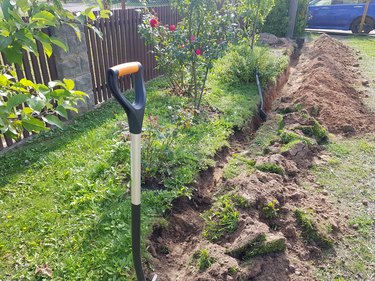
Trench filling should be an easy task, but when you're paying for filling material, such as gravel or concrete, you need to be as accurate as possible. By buying neither too much nor too little, you get the best deal and complete the task without delays. If all trenches were perfectly smooth and regular, the task would be easy, but trenches vary in depth, width, and length. Calculating the correct quantity of infill for a trench is still possible, however, if you follow a straightforward measuring process.
Things You'll Need
Pencil and paper
Video of the Day
How to Calculate the Amount of Fill for a Trench
Keep in mind that accuracy increases as the number of measurements increases, so record the width and depth as often as is practical, paying particular attention to irregular sections of the trench. Take every measurement twice to help eliminate errors and record measurements as you take them. Don't rely on your memory.
Video of the Day
Step 1: Measure the Length
Measure the length of the trench. Lay a tape measure along the ground adjacent to the trench or along the base of the trench if that is flatter. Record the length. Repeat the measurement and if it differs from the first result, continue to repeat the measurement until two results match. Leave the tape measure lying beside the trench.
Step 2: Measure the Width and Depth
Measure the width and depth of the trench at equally spaced intervals along its length. Refer to the tape lying beside the trench to establish the distance between measurements. For example, in a 12-foot-long trench, you may choose to record the dimensions every 3 feet, at the 3-, 6-, 9-, and 12-foot markings along the tape. Record each measurement as you make it.
Step 3: Calculate the Average Width
Calculate the average width by adding the individual measurements together and dividing the total by the number of measurements taken. For example with measurements of 2.0, 2.5, 2.0, 3.0, and 2.0 feet, the average would be (2.0 + 2.5 + 2.0 + 3.0 + 2.0) / 5, or 2.3 feet. Establish the average depth using the same process.
Step 4: Determine the Volume
Calculate the volume of the trench by using this formula: Volume = Width x Length x Depth. As an example, a trench 12 feet long with an average width of 2.3 feet and an average depth of 5 feet has a volume equal to (12 x 2.3 x 5), or 138 cubic feet.
Step 5: Convert Cubic Feet to Cubic Yards
Convert the volume in cubic feet to cubic yards. Soil, concrete, and other fill materials are usually sold by the cubic yard. There are 27 cubic feet in 1 cubic yard, so divide the value in cubic feet by 27 to convert to cubic yards. In the above example, the conversion would be 138/27 = 5.1 cubic yards.
Warning
Do not enter deep or unstable trenches without taking the appropriate safety measures.